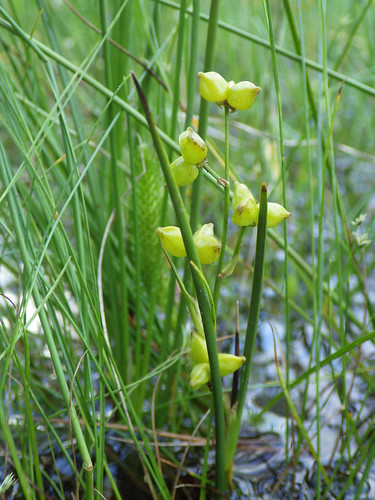 Species Factsheets
Species Factsheets
Scheuchzeria palustris
Pod-grass
State Status: Pennsylvania Endangered (PE)
PBS Status: Pennsylvania Endangered (PE)
Federal Status:
Global Rank: G5
![]() rank interpretation
rank interpretation
State Rank: S1
Did You Know?
If the raw fruit of this species were to be squeezed it would give off a pool like, chlorine smell.
Description
Pod-grass (Scheuchzeria palstris) is a perennial grass-like plant, greatly resembling a rush (Juncus sp.), with a zig-zag stem that may grow to 1.5m in height. The plant often forms colonies because of the presence of wide-spreading underground stems, or rhizomes. The hairless leaves are alternately arranged, consisting of a prominent basal sheathing portion that envelopes the stem and a linear and elongate, ascending blade that is 5-30cm in length and less than 1-4mm in width. The most distinctive leaf feature may be the presence of a small pore-like opening just below the tip. The minute flowers, appearing in late May to July, are greenish and often tinged with yellow or red, 2-4mm in length, and occur in stalked clusters above the leaves. The plant gets its common name, and is probably most conspicuous, in the fruiting stage, which consists of a dry pod, typically grouped in threes and connected at their bases, containing small seeds.
Rank Justification
Critically imperiled in the nation or state because of extreme rarity (often 5 or fewer occurrences) or because of some factor(s) such as very steep declines making it especially vulnerable to extirpation from the state.
Habitat
Pod-grass has a transcontinental range across the cooler regions of North America. In Pennsylvania, it represents a northerly species, and has been documented historically mostly in the northern counties. It grows in bogs and peaty wetlands.
Survey Dates
Flowers, fruits late June - early August
Distribution

Threats
The viability of populations of pod-grass and its habitat may be enhanced by creating buffers and protecting the natural hydrology surrounding wetlands and controlling invasive species. Pod-grass is often an indicator for bog habitats that may feature various orchids, insectivorous plants such as sundew, bladderwort, and pitcher plant, and other interesting species.
Conservation Status Map


NatureServe. 2017. NatureServe Explorer: An online encyclopedia of life [web application]. Version 7.1. NatureServe, Arlington, Virginia. Available https://explorer.natureserve.org.
https://www.luontoportti.com/suomi/en/kukkakasvit/rannoch-rush
- NatureServe. 2018. NatureServe Explorer: An online encyclopedia of life [web application]. Version 7.1. NatureServe, Arlington, Virginia. Available at https://www.natureserve.org/explorer
- Pennsylvania Natural Heritage Program. 2018.
- Rhoads, A.F. and W.M. Klein, Jr. 1993. The Vascular Flora of Pennsylvania. American Philosophical Society, Philadelphia, Pennsylvania. Rhoads, A.F. and T.A. Block.
- 2007. The Plants of Pennsylvania: An Illustrated Manual. 2nd edition. University of Pennsylvania Press, Philadelphia, Pennsylvania.







